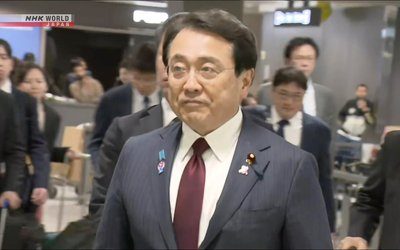
The White House announced Friday that President Trump would hold a second summit with North Korean leader Kim Jong Un in late February as the two sides seek to jump-start nuclear talks that have bogged down since their historic first meeting last year.
The news came after Trump met for about 90 minutes in the Oval Office with Kim Yong Chol, a former spy chief who has been Pyongyang’s lead negotiator. White House aides disclosed no other logistics, but one location that has been strongly considered is Danang, Vietnam, people familiar with the negotiations said.
“We’ve continued to make progress,” White House press secretary Sarah Sanders told reporters after the meeting. She emphasized that the administration would “keep pressure and sanctions on North Korea until we see fully and verified denuclearization.”
South Korea’s presidential Blue House welcomed the news and said Seoul would cooperate with the countries involved “to produce a specific and substantial outcome” for the complete denuclearization of the Korean Peninsula and the establishment of a “peace regime.”
“We expect this summit between North Korea and the United States to be a turning point for building up permanent peace on the Korean Peninsula,” Kim Eui-keum, a spokesman for the Blue House, said in a statement early Saturday.
The announcement of the second summit reaffirmed Trump’s commitment to a strategy in which he has placed faith in his own negotiating skills to cut through years of mistrust and dead-end talks among lower-level diplomats and forge a deal for North Korea to relinquish a nuclear weapons program that analysts said can now reliably strike the United States.
Kim Yong Chol, the lead negotiator for North Korea, met Secretary of State Mike Pompeo at the State Department ahead of a possible meeting with President Trump.
Yet nuclear experts have said there has been no demonstrable progress since the first summit in Singapore last June, and Trump’s claims that North Korea is a diminished threat have been contradicted by the Pentagon and U.S. intelligence agencies.
“While a possible new avenue to peace now exists with North Korea, it continues to pose an extraordinary threat and the United States must remain vigilant,” the Pentagon’s Missile Defense Review, made public this week, concluded.
In recent months, the talks have stalled as North Korea refused demands from U.S. negotiators to provide a detailed inventory of its nuclear and missile programs. Kim Jong Un has made clear he objects because doing so would be tantamount to giving the United States a list of targets.
Instead, Pyongyang has insisted that the United States lift economic sanctions on North Korea and offer a security guarantee to the isolated regime before it makes any further concessions.
With little progress on the technical end of the negotiations among diplomats, the fate of the talks could rely on Trump’s changing the current trajectory in direct interactions with senior North Korean officials.
A second summit “is not necessarily great news,” Richard Haass, president of the Council on Foreign Relations, warned on Twitter. He said Trump must insist on a “detailed roadmap” and added that the outcome “depends on how well a summit is prepared and handled and what @realDonaldTrump offers and demands in return. Recent history hardly reassuring.”
For Trump, a second summit could help him make the case that his top foreign policy initiative is paying off and divert attention from his escalating domestic political troubles.
The president is embroiled in an increasingly nasty public fight with congressional Democrats as a partial government shutdown over funding for his proposed border wall reached the four-week mark Friday. And the White House has been rocked by new revelations in the special counsel investigation into Russian interference in the 2016 presidential election.
Friday marked the second time Trump has welcomed Kim Yong Chol, who was reported to be delivering a letter from Pyongyang. He also visited Trump in the Oval Office last June to seal plans for the leaders’ summit later that month in Singapore — the first time a sitting U.S. president met a North Korean leader.
Unlike the first visit, however, during which a smiling Trump was photographed accepting an oversize envelope from the emissary, reporters were not permitted to view any portion of the meeting in the Oval Office.
Before arriving at the White House, Kim met for less than an hour with Secretary of State Mike Pompeo at a hotel in Washington’s Dupont Circle neighborhood. The two parties met for lunch there after Kim returned from the White House.
Trump allies praised the president’s leadership and expressed cautious optimism that the high-level engagement would pay dividends. “President Trump deserves great credit for getting us to this point,” Sen. Lindsey O. Graham (R-S.C.) said in a statement. “We have a long way to go, and I’m hopeful that the engagement started by President Trump can finally end the North Korean problem in a win-win fashion.”
Trump has been upbeat about a second round of face-to-face negotiations with Kim Jong Un, touting personal letters from him.
“With North Korea, we have a very good dialogue,” Trump said this month. “I’m going to not go any further than that. I’m just going to say it’s very special.”
Trump stated after the Singapore summit that North Korea was no longer a nuclear threat to the United States, and Pyongyang has maintained a now 14-month hiatus on missile and nuclear-bomb testing, for which Trump frequently claims credit.
Courtesy: The Washington Post
- India Supported Construction Of Four Schools In Nuwakot
- Mar 19, 2021
- Nepal Denies Permission For Third Phase Trial Of Vaccine Against COVID-19
- Aug 31, 2020
- Messi Can Only Cancel Barcelona Contract If €700 Million Release Clause Is Paid, La Liga Confirms
- Aug 31, 2020
- India To Carry Out Study On Kathmandu-Raksaul Railway
- Aug 28, 2020
- COVID-19: 1,351 Personal Of Nepal Police Infected
- Aug 28, 2020















